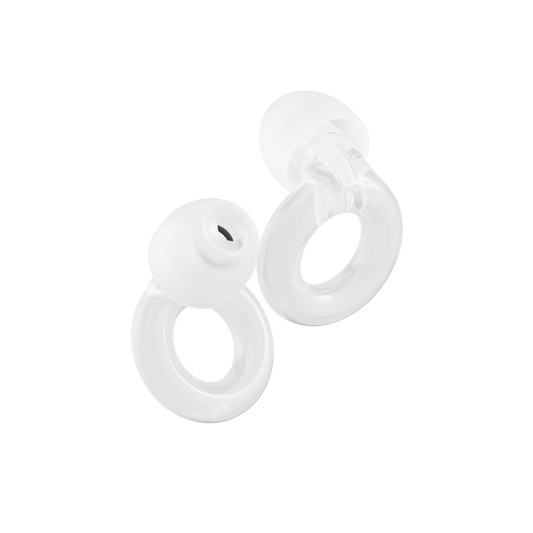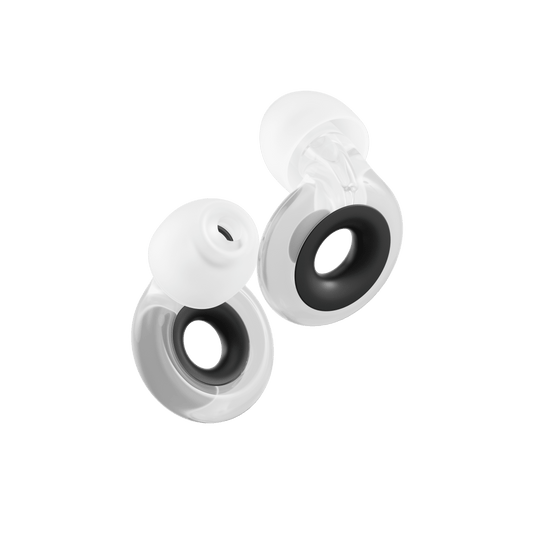Key takeaways:
- Misophonia is an intense emotional reaction to specific sounds, many of which are commonly encountered in the workplace, like chewing, typing and pen clicking.
- It can have a big impact at work, including attendance issues and challenges with colleagues.
- Coping strategies include open communication, using noise-reducing earplugs, creating a supportive work environment and implementing stress-reduction techniques like deep breathing and mindfulness.
Do you feel a sense of rage when your colleague eats their lunch with their mouth open? Do you feel your blood pressure rising at the sound of the coffee machine, printers and phones ringing? Do you get annoyed by the person at the next desk talking on the phone?
All of these are signs that you might have misophonia, an intense emotional reaction to specific sounds. Seemingly innocuous sounds can stir up negative emotions like anger, anxiety or disgust in people with misophonia – and at work, that could mean things like chewing, typing, pen clicking, or rustling papers.
If these types of noises cause an intense reaction for you, it can be difficult to cope with at work – where there’s unavoidable noise everywhere. But there are ways of dealing with misophonia at work, no matter where you work. From using noise-canceling headphones to mask trigger sounds, to requesting accommodations like designated quiet areas, there are ways to reduce the impact of misophonia and make your working life more comfortable. But if you don’t get help with misophonia at work? It can potentially lead to increased stress levels, reduced productivity and have a big impact on your mental wellbeing.
So, with that in mind, here’s everything you need to know about how to deal with misophonia at work, for a happier, healthier and more productive working life.
The impact on misophonia at work
Misophonia is fairly common, with studies showing that 1 in 5 people in the UK have the condition. But even though it’s fairly common, it’s not a particularly well understood condition – and that means it can have a big impact, both on your personal and professional life.
Some of the ways it can impact you at work include:

Attendance issues
If you struggle to deal with triggering noises at work, you might be tempted to call in sick just to avoid those noises. Or, even if you show up at work, the distress the noises can cause may mean you frequently need to take breaks or aren’t productive as you try to manage that emotional distress.
That’s where clear communication comes in. Being open and honest with your workplace about your condition is essential, as your manager may be able to make adjustments to help you cope. You might be able to work flexibly, for example, or shift to a different working pattern to help you better manage your symptoms without sacrificing productivity.
Limited career choices
Some workplaces are louder than others – and that means that certain job roles or industries may be off the table for individuals with misophonia. You may find yourself constrained in your career choices if you’re trying to avoid environments full of triggering noises.
Again, this is where communication is key. You shouldn’t need to limit your career choices just because you have misophonia. Don’t be afraid to speak to employers and potential employers to find out what accommodations can be made to help you better deal with misophonia at work.
Challenges with colleagues
Misophonia can strain relationships with colleagues, which can sometimes lead to conflicts or social isolation. Imagine the coworker sitting beside you clicks his pen all day, every day. That noise frustrates you, leaving you feeling anxious and angry. Eventually, you snap at him, and it leads to a heated argument – not a great thing to happen in the workplace.
The frustration and anxiety caused by certain sounds can lead to misunderstandings and resentment – but again, communication can help to reduce the risk of this. Addressing misophonia openly and educating coworkers about the condition can help to foster understanding and minimize conflict.
Career advancement
If your role requires lots of networking or public speaking, you may find yourself turning down opportunities, worried about attending conferences, networking events or delivering presentations due to potential triggers – and in some industries, these things are crucial if you want to get ahead in your career.
Exploring alternative methods to demonstrate your skills, like written communication or virtual presentations, can help people with misophonia showcase their abilities without being hindered by their condition.
Strategies for coping with misophonia at work
Managing misophonia in the workplace can be challenging, but there are strategies that can help you cope effectively. Here are some practical tips to learn how to cope with misophonia at work:


Self-awareness and education:
As you may already be aware, there is a link between misophonia, sound sensitivity, and anxiety. Everyone reacts differently to misophonia and its triggers. If you have a mild reaction to certain triggers you might experience misophonia symptoms such as:
- Anxiety
- Feeling uncomfortable
- The urge to flee
- Disgust
Featured collection
-
Engage 2 Plus
Regular price €39.95Sale price €39.95 Regular priceUnit price perAn upgrade to Engage 2, with extra noise reduction on demand
It’s also possible to have a more severe reaction at times, creating stronger responses such as:
- Rage
- Anger
- Hatred
- Panic
- Fear
- Emotional distress
In any case, misophonia is no laughing matter. Those with the misophonia have been known to develop anticipatory anxiety when going into situations where trigger sounds may be present.
Everyone has different triggers, so as someone who suffers from misophonia, it is important to know where your limits lie and to anticipate situations that might trigger a response. If you’re aware of your triggers and reactions, it can help you better manage your responses.
Creating a supportive work environment:
The next step to managing your misophonia in the workplace is to inform your colleagues. Only when people at work know about your sound sensitivity, can they take it into account. So let’s start there: time to tell your co-workers about misophonia. There are many misunderstandings about disorders like misophonia (and others, like autism). People might ask questions like “is misophonia a mental illness?” so be prepared to debunk some myths.
It is important that you communicate that misophonia is a recognized disorder that reduces your tolerance to certain sounds, often triggering intense emotional or physiological responses. Next, explain your misophonia triggers. This could range from the sound of marker on a whiteboard, to chewing noises at lunch. Don’t hold back: be up-front about what sets you off. Also think about your ideal misophonia “treatment”: feel free to come up with suggestions yourself and request reasonable accommodations, such as noise-reducing earplugs or a quieter workspace to minimize exposure to triggers.
You could also ask to work from home part-time, or to employ flexible scheduling so that you can respond to the fluctuations in your sensory overload.
If meetings or sharing office space with colleagues are posing problems, you may want to approach individual colleagues who are making noises that trigger you. If you go to them privately and stay calm and diplomatic, chances are it is simply a question of awareness and they will be happy to adapt.
Explain what causes misophonia and which noises you react to specifically, if you think there is a reasonable chance that the conversation will be productive.
Implementing stress-reduction techniques:
If it gets tough and work and you find it hard to deal with triggering noises, there are plenty of discreet stress-reduction techniques you can use at work to help manage misophonia triggers without drawing any attention to yourself:
- Deep breathing exercises can be done quietly at your desk to promote relaxation and alleviate tension
- Mindfulness – focusing on the present moment – can help you to stay calm and focused when faced with triggering sounds
- Listening to calming music to create a soothing environment and reduce the number of potential trigger sounds you can hear.
Beyond the workplace, incorporating regular physical activity and stress management techniques can significantly improve your overall wellbeing. Finding an activity you like, whether it’s yoga, running or hitting the gym, is the best way to ensure you regularly incorporate movement into your life. And that can significantly reduce stress levels and improve your resilience to triggers.
What’s more, relaxation techniques like progressive muscle relaxation or guided meditation outside of work can help to improve your coping skills, help to better manage stress, and reduce the impact of triggering noises.
Time management and breaks:
It’s important for everyone to take breaks during the working day – and people with misophonia are no different. Taking regular breaks in quiet areas gives you the opportunity to relax and recharge. Whether it’s a short walk outside, practicing deep breathing exercises, or listening to calming music, incorporating regular breaks into your work day can help to enhance your focus and resilience to triggering noises.
By prioritizing time management and taking proactive steps to manage stress, you can create a more comfortable and productive work environment, even when you’re exposed to noises that trigger your misophonia.
Using noise reduction earplugs for workplace relief
One of the most effective ways to deal with misophonia at work is to reduce stimuli in your work area. This can mean using space enclosures or sound absorption panels to block noise, or using a private office.
Or perhaps your employer will let you use white noise or environmental sound machines to help you focus. You can also ask to listen to soothing music like a white noise playlist, or use a noise canceling headset.
If you want to take a more discreet approach, earplugs for misophonia offer a more subtle way to filter out noise without blocking it out completely or creating distance. It’s not recommended that people with misophonia wear earplugs constantly, as it can make the condition worse in the long run. But they’re an excellent tool in helping you to build up tolerance to triggering sounds.
Wearing earplugs like Loop Engage help to take the edge off triggering sounds, helping you to reduce the risk that you’ll be bothered by triggering noises – giving you the confidence that you’ll stay cool, calm, and in control at work.
Final thoughts:
Managing misophonia in the workplace can be challenging – but it can be done. You just need a little communication with your managers and colleagues, and a focus on self care.
You can benefit from discreet stress-reduction techniques to minimize exposure to triggers and reduce stress levels, and open communication with colleagues and supervisors helps to improve understanding. Advocating for your needs will help to ensure you’re better able to deal with misophonia at work, creating a more supportive work environment.
By prioritizing self-care and seeking support, you can navigate the challenges of the workplace more effectively while preserving your mental and emotional well-being.










































